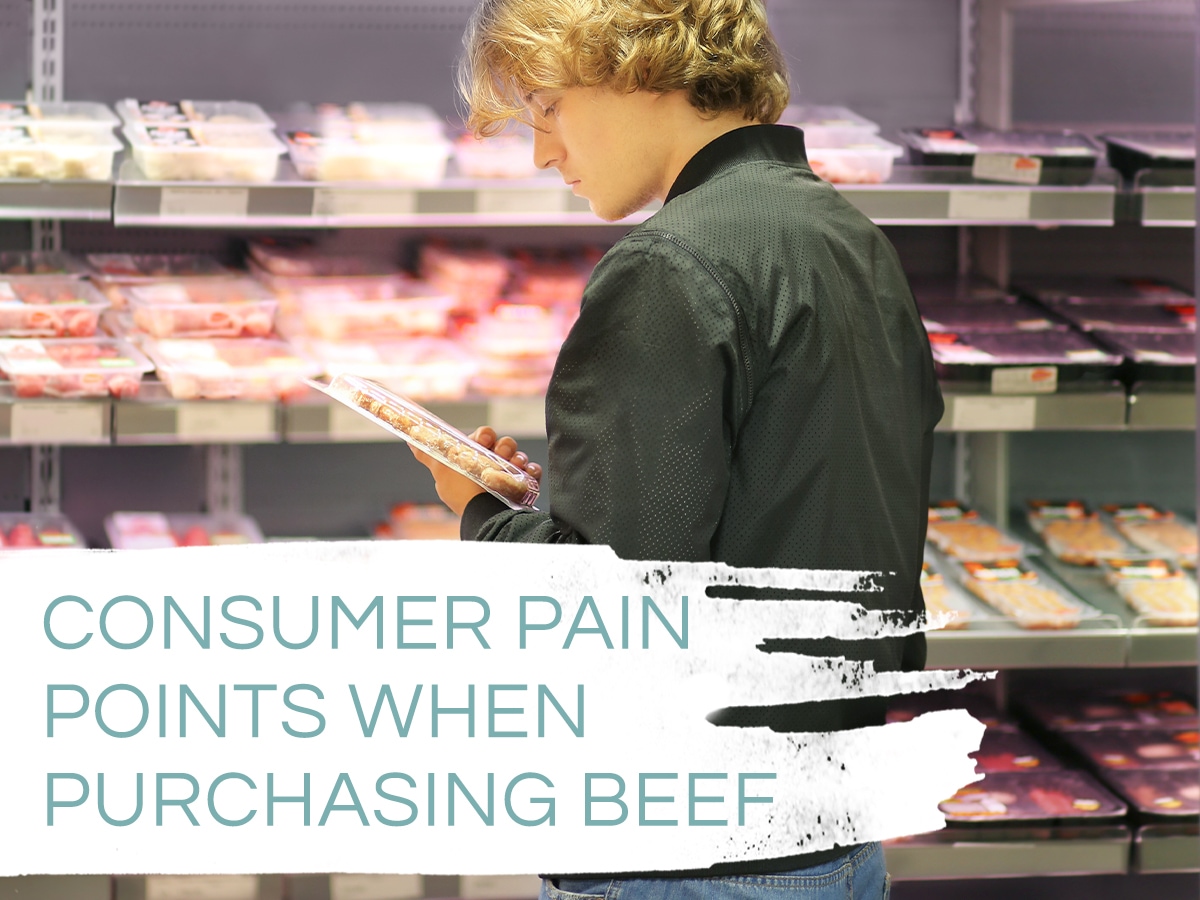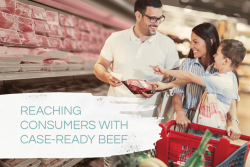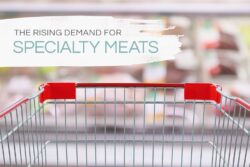
Top Consumer Pain Points When Purchasing Beef and How to Overcome Them
Jul 9, 2025
For today’s shopper, the grocery store can either be a place to explore and find inspiration—or it can be a place of stress and uncertainty. An increasing number of grocery shoppers are feeling that anxiety because there are multiple complicated factors influencing their decisions, from product claims and price to quality and availability.
We’ve written this blog to help you get an accurate birds-eye view of top consumer pain points and discover how you can use smart strategies (and premium natural Angus beef) to mitigate them. Let’s reduce stress, inform confident purchasing, and help you bring happy customers back to your store for repeat business.
1. Information Overload
The average grocery store carries 300,000+ SKUs and product packaging often includes dozens—even hundreds—of messages, including item descriptions, marketing copy, ingredients, and nutrition facts. That all compounds to make the typical shopper the recipient of an avalanche of information, causing analysis paralysis and thwarted purchases.
By the Numbers
- 73% of consumers feel overwhelmed by too many choices—and 74% of that group are walking away from purchases because of it
- While 74% of consumers enjoy browsing for inspiration and discovering new things, 71% wish they could identify available options that suit their needs more quickly and easily
Solutions
- Prioritize brevity. Look for products with user-friendly, minimalistic packaging. Better yet, aim to stock products with a short list of wholesome ingredients. For instance, popcorn flavors with just three ingredients—or natural ground beef, which has just one.
- Leverage product reviews. Sometimes, a glowing review can be much less confusing and more persuasive than a generic product description. Think of it as your customer talking to a friend versus reading a fact sheet. In fact, 72% of shoppers value personal recommendations and reviews when making a grocery purchase.
2. Confusing Labels
In addition to being overwhelmed by information, some of the information shoppers receive is vague and hard to understand. Labels and packaging throw around claims like “local,” “ethically sourced,” and “sustainable,” without providing definitions, leaving many customers in a state of puzzlement.
But which beef labels are causing confusion? Research finds that 40% of all shoppers think the terms “natural” and “organic” mean the same thing, and that uncertainty leads almost a fifth of those who rely on conventional goods to avoid buying natural and organic products due to confusion. That’s a big missed opportunity for retailers who work hard to cater to natural and organic shoppers.
By the Numbers
- 72% of shoppers are confused by metrics used to explain a product’s features or benefits
- 76% struggle to know whether a product delivers on its promises
Solutions
- Know your natural. Natural beef is different from Certified Organic. Certified Organic applies to living conditions and feed, and products must be third-party validated according to specified standards to receive certification. Natural beef and Certified Organic beef are often raised and fed in similar ways, but natural beef producers do not need to adhere to specific requirements set forth by a third party. That’s why it’s essential to know your beef producers and understand how they raise cattle.
- Provide facts and figures. 77% of shoppers value facts and figures when making a grocery purchase decision. For those shoppers, logical, numbers-based information can clear up confusion when unclear, arbitrary adjectives like “ethical” are used.
- Train on benefits. Educate your staff so that they’re able to accurately share product benefits and features. Shoppers can then more quickly and easily find what they need with help from your staff—and your crew will become a trusted resource for customers. Win-win.
3. Lack of Understanding When it Comes to Beef Cuts
Grocers have dozens of popular beef cuts to choose from—but for the average shopper, telling them apart can be confusing. Without clear information, they’re left wondering: Is ribeye really worth more than chuck eye when they look almost the same? What kind of ground beef should I buy? Am I overpaying for this cut? When details are missing, choosing between beef cuts becomes a guessing game.
Solution
There are a ton of helpful resources available online and, hopefully, from your beef provider about the different kinds of cuts, where they come from on the animal, and the tenderness, flavor, and texture each cut provides. This chart from Beef. It’s What’s For Dinner. brings you all that information in one place.

Wondering what steaks you should stock? Check out our blog post Steak Cuts Ranked: The Best Beef for Your Business. This resource ranks steak cuts by margin for retailers like you.
4. Sustainability and Ethics Concerns
It seems that every company has a sustainability section on their website, and many food products allude to being made with lofty principles in mind. But even though this kind of messaging isn’t new, consumer demand for these products continues to grow.
By the Numbers
- Consumer interest in sustainable food and beverages has grown by 18.4% over the past two years
- 72% of Americans have “an urgent need for a more sustainable way of eating”
Solution
Stock beef products with sustainable and ethical practices that align with your business and your customers’ preferences. Do a little digging to make sure you can trust what those partners say.
Aspen Ridge® Natural Angus Beef is proud to stand by strict production standards.
- No antibiotics ever: no antibiotics are administered to cattle
- No added hormones ever: no growth hormones are used in the raising of cattle
- Naturally raised: cattle are raised with access to pastures
- Ethical raising: animals receive ample space and access to food, water, and shelter
- Net-zero: JBS Foods, which includes Aspen Ridge Natural Angus Beef, has pledged to achieve net-zero GHG (greenhouse gas) emissions
5. Inability to Gauge Quality and Freshness
When you spend your hard-earned money on groceries, you want to feel confident it’s money well spent. Shoppers want to know they’re getting a good deal—and when they choose premium products, they expect the quality to match the price. That’s why more than a third of shoppers say quality matters most. The challenge? Many aren’t sure what true quality looks or feels like. And, they sometimes struggle to identify high-quality beef.
By the Numbers
- 36% of shoppers say quality is most important when making a purchasing decision
- 1 in 4 are not confident in their ability to make a choice that is the best quality
- The use of food-date labels such as “use-by” and “best if used by” causes consumer confusion that results in many Americans discarding food that is safe to eat or donate
Solutions
- Choose vacuum-sealed beef. Vacuum-sealed, case-ready beef is less permeable to air than beef on trays with cling overwrap. Vacuum sealing keeps beef looking (and staying) fresher longer in the meat case and prevents beef storage issues for consumers once they get home.
- Help customers understand food-date labels. Share this helpful information on your social media channels and with your staff. Or, hang signage in your store to show customers that you care about providing products with the utmost quality and freshness.
Beef and Date-Labels
- Best if used by/best if used before: Sets an end date for the period that a product is of best flavor or quality
- Use by: The last date recommended for the use of the product while at peak quality
- Sell by: Tells the store how long to display the product for sale
- Freeze by: When a product should be frozen to maintain peak quality
Note that none of these dates are claims as to the safety of a product—they all relate to quality. While many products are still safe after the date passes, we do not recommend eating beef past its date (best if used by, best if used before, or use by). And, while many people associate bright red color with beef freshness, a change in color is not a reliable indicator of spoilage.
6. Nutritional and Dietary Needs
The U.S. Office of Disease Prevention and Health Promotion believes that food can be medicine; smart eating is an essential tool to reduce nutrition-related chronic diseases. Moreover, certain foods are scientifically shown to help people combat health conditions. Food allergies are more prevalent than ever. In summary, modern shoppers need to measure food against a long list of nutritional and dietary concerns, forming a roadblock between browsing and purchase.
By the Numbers
- Half of consumers rate high protein as a “medium-high” or “high” ingredient factor when buying food products
- 40% prefer foods with no artificial ingredients
- 85 million U.S. shoppers avoid allergens when shopping for food and beverages
- People are allergic to more than 160 ingredients in food, but nine account for most reactions and incidence in the United States: milk, eggs, wheat, fish, shellfish, peanuts, tree nuts, soy, and sesame
Solutions
- Stock natural beef. Beef is made with nothing else—it’s just beef. No complex ingredient lists for consumers to read through. And because beef is not one of the “Big 9,” most shoppers will not have beef allergy concerns. Plus, beef packs a wealth of essential nutrients in every 3-ounce serving, including 51% of your Daily Value of protein.
- Train your staff. Leaders are responsible for training food employees about the serious nature of food allergies, like allergic reactions and more serious conditions like anaphylaxis. Make them aware of the Big 9 allergens as well so they can be extra careful when handling those items (to avoid product spillage or packaging damage).

Want more nutrition info? Explore how different kinds of ground beef (chuck, round, and sirloin) measure up when it comes to nutrition, flavor, and preparation needs.
7. Lack of Confidence in Cooking Skills
There’s nothing worse than investing time and money in a new recipe, only for it to fail spectacularly. Well, guests laughing at a failed recipe might be worse. Consumers are often frustrated by a lack of knowledge and skill in the kitchen, but you can help them be more self-confident cooks.
By the Numbers
- A survey of 2,000 people found that when it comes to their skills in the kitchen, 37 percent have felt judged by others
- Over half (52%) of respondents admitted they’ve had a full-on kitchen disaster, prompting 31% of those to trash it and start from scratch
- Lack of knowledge was a barrier to cooking for 34% of respondents
Solutions
- Lean into social media. Share recipes and beef cooking techniques on your social channels to inspire customers and connect with current and potential ones. Social media has been shown to reduce kitchen intimidation—more than half of Americans (56 percent) reported increased confidence in the kitchen thanks to social media.
- Highlight showstopper products. When home cooks have one “anchor” ingredient in a recipe, the rest is a cake walk. An intensely marbled New York strip steak, for instance, doesn’t need much more than salt, pepper, and a hot pan. Star ingredients like beef take the guesswork out of recipes for shoppers, letting them serve impressive meals to guests without stress.
- Explore ingredient pairings. After you share recipes on your social media, consider placing key ingredients next to each other for easier shopping. For instance, you might stock a trendy or popular spice rub or marinade right next to the meat case during grilling season.
8. Price Concerns
Price is a concern for today’s shoppers, with 88% saying they’re frustrated by rising costs across categories like groceries, gas, and restaurants. Beef price fluctuations are also a common worry. As a result, many consumers are changing how they shop: stocking up during sales, cutting back on items, and sticking closely to their lists. But even in this climate, there’s room for success. With a trusted supplier, smart promotions, and the right premium offerings, you can stay competitive, drive loyalty, and turn price-sensitive shoppers into repeat customers.
By the Numbers
- 37% of consumers say price is the most important factor when it comes to making grocery purchases
- More than 1 in 4 (27%) are not confident in their ability to make a purchase decision that is the best possible price
Solutions
- Partner with a supplier you trust. A reliable beef partner will be transparent and consistent with pricing, giving you peace of mind.
- Leverage strategic promotions. Work with our sales team to build value-driven promotions like BOGO deals or wine-and-beef pairings that boost perceived value.
- Go premium. Though price is a concern, 94% of consumers say they’re willing to “trade up” for meat during special occasions and holidays. By stocking a premium product, you can always deliver for those high-expectation moments.
9. Product Availability Issues
Today’s shoppers are facing more out-of-stocks than ever, with two thirds of them reporting that the items they want are sometimes, regularly, or always unavailable. When shelves are empty, customers walk away—not just from that product, but sometimes from the entire store. Avoiding missed sales starts with a beef partner who can keep up with demand and deliver what you need, when you need it.
By the Numbers
- 62% of consumers say products they’re interested in are sometimes, regularly, or always unavailable
- 30% of U.S. consumers who experience regular out-of-stocks at a grocer say they would question their loyalty to that chain
Solutions
- Choose a dependable partner. Working with a beef brand you can count on—with a hands-on, helpful sales team—means fewer gaps in supply and a stronger ability to meet customer demand.
- Benefit from strong supply infrastructure. Aspen Ridge Natural Angus Beef is backed by JBS, one of the world’s largest beef providers, which means more consistent product availability and flexible fulfillment for you.
Partner with a Beef Supplier You Can Rely On
Today’s shoppers face no shortage of obstacles on their path to purchase—but with the right protein partner, you don’t have to face them alone. Aspen Ridge Natural Angus Beef can help you navigate these challenges, stand out in a crowded market, and keep customers coming back. Connect with our sales team to explore how a retail partnership can work for you.
Sources
1 Consumer Packaged Goods and Pharmaceuticals & Medical Products Practices (2020, September 22). Consumers with food allergies: A growing market remains underserved. McKinsey & Company. https://www.mckinsey.com/industries/consumer-packaged-goods/our-insights/consumers-with-food-allergies-a-growing-market-remains-underserved
2 Ewing-Chow, D. (2024, October 23). Top Tips And Trends For Sustainable Eating In The U.S. Forbes. https://www.forbes.com/sites/daphneewingchow/2024/10/14/top-tips-and-trends-for-sustainable-eating-in-the-us/
3 Koppes, S. (2023, December 13). Consumers grapple with confusion over food-date labels. College of Agriculture. https://ag.purdue.edu/news/2023/12/consumers-grapple-with-confusion-over-food-date-labels.html
4 Morrison, K. (2025, February 12). 2025 Consumer Food Trends: Prioritizing Health and Nutrition. Food Industry Executive. https://foodindustryexecutive.com/2025/02/2025-consumer-food-trends-prioritizing-health-and-nutrition/
5 Mueller, S. (2025, April 4). Inventory Distortion Is A Grocer’s Worst Nightmare: How Optimizing On-Shelf Availability Will Help Them Rest Easy. Forbes. https://www.forbes.com/councils/forbestechcouncil/2025/04/04/inventory-distortion-is-a-grocers-worst-nightmare-how-optimizing-on-shelf-availability-will-help-them-rest-easy/
6 Petrak, L. (2024, May 1). ‘Overwhelmed’ Consumers Walking Away From Some Purchases. Progressive Grocer. https://progressivegrocer.com/overwhelmed-consumers-walking-away-some-purchases
7 Roerink, A. M. (2025). The Power of Meat 2025. The Annual Meat Conference.
8 Silverstein, S. (2025, February 21). Consumer confusion holds back sales of natural and organic products, research finds. Grocery Dive. https://www.grocerydive.com/news/natural-organic-acosta-group-grocery-retail/740639/
9 The Packer Staff (2024, October 3). Consumers frustrated with rising grocery prices, survey finds. Produce Market Guide. https://www.producemarketguide.com/news/consumers-frustrated-rising-grocery-prices-survey-finds
10 U.S. Department of Agriculture (n.d.). Food Product Dating. Food Safety and Inspection Service. https://www.fsis.usda.gov/food-safety/safe-food-handling-and-preparation/food-safety-basics/food-product-dating
11 U.S. Department of Health and Human Services (n.d.). Food Is Medicine: A Project to Unify and Advance Collective Action. Office of Disease Prevention and Health Promotion. https://odphp.health.gov/our-work/nutrition-physical-activity/food-medicine
12 (2020, February 4). Americans feel confident in their ability to cook this one meal, study finds. WDRB. https://www.wdrb.com/wdrb-in-the-morning/americans-feel-confident-in-their-ability-to-cook-this-one-meal-study-finds/article_5e546d20-4750-11ea-bd85-5beda33f3036.html
13 (2023, March 1). Kitchen Intimidation No More – New Report Reveals More Than Half of Americans Credit Social Media for Their Kitchen Confidence. PR Newswire. https://www.prnewswire.com/news-releases/kitchen-intimidation-no-more–new-report-reveals-more-than-half-of-americans-credit-social-media-for-their-kitchen-confidence-301755669.html





